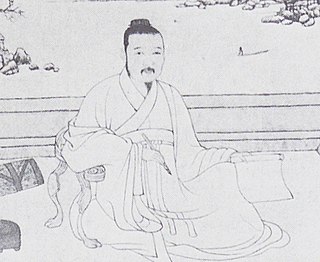
Xu Wei, also known as Qingteng Shanren, was a Chinese painter, playwright, poet, and tea master during the Ming dynasty.

Mei Yaochen (1002–1060) was a Chinese poet of the Song dynasty. He was one of the pioneers of the "new subjective" style of poetry which characterized Song poetry.

Wen Tong (1019–1079) was a Northern Song painter born in Sichuan famous for his ink bamboo paintings. He was one of the paragons of "scholar's painting", which idealised spontaneity and painting without financial reward.

Ni Zan was a Chinese painter during the Yuan and early Ming periods. Along with Huang Gongwang, Wu Zhen, and Wang Meng, he is considered to be one of the Four Masters of the Yuan Dynasty.

Huang Shen (1687–1772) was a Chinese painter during the Qing Dynasty. Huang was born in Ninghua, Fujian province, to a poor family. His courtesy names were Gongshou (恭壽) and Gongmao (恭懋). His pseudonym was Yingpiaozi (癭瓢子).

Eight Eccentrics of Yangzhou is the name for a group of eight Chinese painters active in the eighteenth-century, who were known in the Qing Dynasty for rejecting the orthodox ideas about painting in favor of a style deemed expressive and individualist.

Luo Ping was a Chinese painter of the Qing Dynasty who lived in Ganquan (甘泉; present-day Yangzhou, Jiangsu. His courtesy name was Dunfu and his pseudonyms were Liangfeng and Huazhisi Seng. He studied painting under Jin Nong and developed a unique personal style. He painted people, Buddhist images, plum with bamboo, flowers, and scenery paintings. He refused government service to live a life of poverty selling paintings. He was the youngest of the Eight Eccentrics of Yangzhou.
Gao Lian, was Chinese writer, dramatist and encyclopedist.

Cui Bai was a prominent Chinese painter of the Northern Song Dynasty (960–1279). A native of Anhui Province, Cui was best known for paintings of animals and plants. At some point during his life, he traveled to the capital of Kaifeng to seek employment as a court artist, and was accepted by Emperor Shenzong of Song, who admired his works. He became a renowned artist of Shenzong's court, but gained an awkward reputation for his often eccentric behavior.
Xiao Yuncong was a famed Chinese landscape painter, calligrapher, and poet during the late Ming and early Qing dynasties.

Xi Gang ; 1746-1803 was a renowned seal carver and painter in Qing Dynasty. He was born in Qiántáng. His style name was Chunzhang (纯章) and his pseudonym was Tiesheng (铁生). Other names include Hezhusheng (鹤注生) and Mengquan Waishi. His specialty was in painting landscapes. His seal carving method was similar to that of Ding Jing (丁敬), though somewhat cleaner and sharper. His style is representative of the Southern School. He was also talented in prose and calligraphy.

Ju Chao, a native of Panyu (番禺), now Guangzhou, was a famed Chinese painter in the Qing dynasty. His courtesy name was Meisheng (梅生), and pseudonym Meichao (梅巢) or Guquan. He was the older brother of the painter Ju Lian. He wrote "Poems of Shouxie Shi" (首邪室诗) and "Yanyu Ci" (烟语词).

Cheng Jiasui (1565-1643) was a Chinese landscape painter and poet during the Ming Dynasty (1368–1644).

Du Qiong ; ca. 1396-1474 was a Chinese landscape painter, calligrapher and poet during the Ming dynasty (1368–1644).

Lu Guang ; was a Chinese landscape painter and poet during the Yuan Dynasty (1271–1368). His specific birth and death dates are not known.

Ke Jiusi was a Chinese landscape painter, calligrapher, and poet during the Yuan Dynasty (1271–1368).

Ma Wan was a Chinese landscape painter, calligrapher, and poet during the Yuan Dynasty (1271–1368). His specific dates of birth and death are not known.

Wang Yi ; ca. (1333-unknown) was a Chinese painter of human figures during the Yuan Dynasty (1271–1368). His specific date of death is unknown.
Yan Hui ; was a late 13th-century Chinese painter who lived during the Southern Song and early Yuan dynasties. His specific dates of birth and death are not known. His exquisite brushstrokes were highly regarded.

Ju Lian, a native of Panyu (番禺, now Guangzhou, was a Chinese painter in Qing Dynasty. His courtesy name was 'Ancient Spring', and self-given pseudonym 'Old Man of the Divided Mountain'. He was the younger brother of the painter Ju Chao. He was known for his bird-and-flower paintings as well as people and plant-and-insect paintings. He was the teacher of the brothers Gao Jianfu and Gao Qifeng.

















